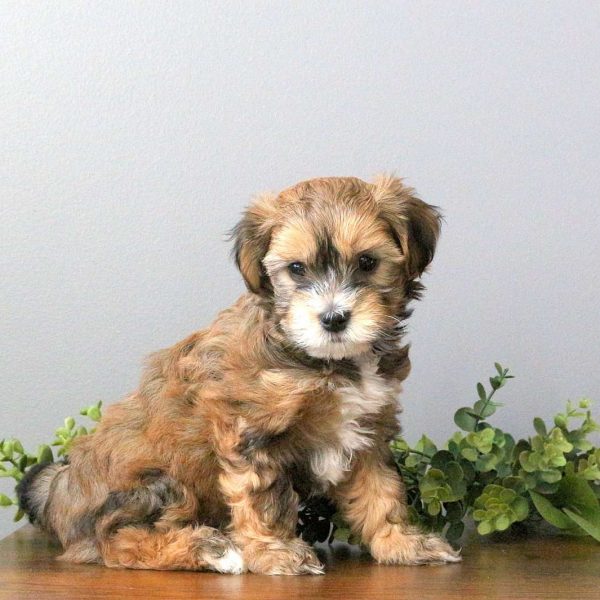
-
Activity Level:
low
-
Shedding Level:
moderate
-
Grooming Level:
high
-
Trainability:
moderate
-
Good for Novice Owners:
moderate
-
Adaptability:
high
-
Kid/Pet Friendly:
often
-
Prey Drive:
high
-
Watchdog:
aware
- Average Size: Small
- Average Lifespan: 12-15 years
- Registered?: other
Havashire Dog Breed Information
Overview
Temperament
Adaptability
Health
Owner Experience
Grooming
Activity Level
Size
Life Span
A Havashire is a cross between a Havanese and a Yorkshire Terrier. Havashires are small dogs that tend to be loyal, playful, and affectionate dogs that love nothing more than being with their favorite humans.
Although they are not recognized by the American Kennel Club, they are recognized by other notable dog organizations. The American Canine Hybrid Club, Designer Dogs Kennel Club, and more recognize the Havashire.
The Havashire is an affectionate, charming, and playful little dog that fits in with just about everyone. They get along well with children, other dogs, other pets, and even strangers. They thrive when they are the center of attention.
Because they are so small, especially as puppies, it is important to closely supervise any playtime with young children. A Havashire can be easily injured by accidental rough play or falls that can be more common with very young children.
Although they generally get along with other pets, they can sometimes inherit a high prey drive from their Yorkshire Terrier parent. So, it’s not a bad idea to be prepared for some extra socialization and training if you have small pets in the household.
They don’t tend to bark a lot, but can easily be trained into it if you’re not careful. If your Havashire starts barking too much, you can start to train them to stop barking to prevent it from becoming a nuisance behavior.
Havahsires are highly adaptable dogs. They do well in apartments as well as larger homes. They do well in most climates. As with any dog breed, they are sensitive to heat. As a small dog breed with a thin coat, they are also sensitive to the cold.
But, bundling up with some key winter dog products can help them stay warm when the temperatures drop. Because these dogs thrive on attention and bond so closely with their families, they do not like to be left alone for long periods of time.
Are mixed-breed dogs healthier than purebred dogs? They can be sometimes, but it’s not a guarantee. Just as they could inherit none of the health conditions common to their parent breeds, they could also inherit any combination of them or all of them.
For the Havashire, potential health conditions to be aware of include luxating patella, Legg-Calves-Perthes disease, progressive retinal atrophy, mitral valve disease, and cataracts. They can also be prone to having allergies and sensitive skin. As a small dog breed, they are also more prone to developing dental diseases.
Reputable breeders will be screening their dogs to prevent passing congenital issues on to puppies. So, make sure you ask about the health and genetic history of both of the parents and about any health tests or clearances that have been done.
A Havashire is a highly trainable dog breed, but they can be challenging at times for first-time dog owners. They are intelligent and eager to please, but they can also be stubborn and will use their charm to push boundaries.
Puppy training classes can help first-time dog owners navigate any obstacles they may have with a Havashire’s stubborn streak. These classes are a good idea regardless because they help strengthen the bond you have with your Havashire and also offer opportunities to socialize them.
A Havashire will have a medium-length silky coat that doesn’t shed much. Although their coat be may low-shedding, you still have some maintenance to do to keep it healthy and looking great. Brushing a few times a week at least, daily brushing is better, is necessary to remove tangles and prevent mats from forming and professional grooming is needed about every 4-6 weeks.
In addition to coat care, you will also need to take care of your Havashire’s nails, ears, and teeth. Although the groomer may be able to take care of some of it during appointments, you will still need to do the rest at home between grooming sessions. Cutting your dog’s nails once or twice monthly is usually enough to keep them from growing too long.
Weekly checks and carefully cleaning your dog’s ears as needed can help prevent ear infections. Brushing teeth or using an enzyme toothpaste every day is ideal dental care for dogs and can help prevent painful dental diseases later in life. As a small dog, the Havashire is more prone to developing dental issues, which makes good dental care even more important.
Havashires are energetic and playful dogs that may seem like they are always on the go. Although they will try to keep up with you because they love to stay by your side, they are also small dogs that will tire out easily.
Daily walks plus some playtime are usually enough for this small dog. They will likely be up to spending more time with you if you want to do more things. Just keep an eye on them to make sure they aren’t overexerting themselves trying to keep up.
A fully-grown Havashire usually stands 8-11 inches tall and weighs 7-11 pounds.
A Havashire generally lives for 12-15 years.






